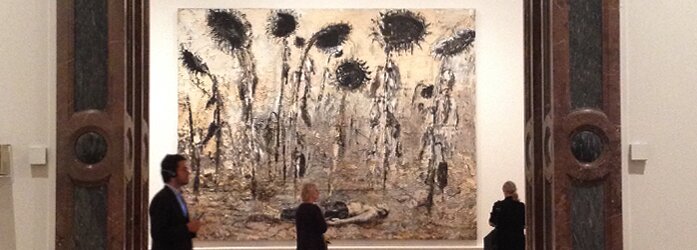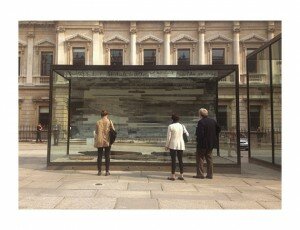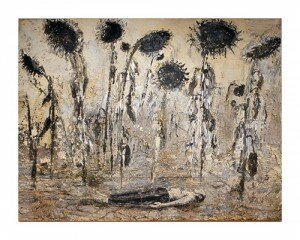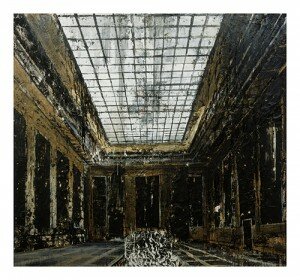
Anselm Kiefer, The Orders of the Night (Die Orden der Nacht), 1996. Photo by Yanti Sastrawan/Royal Academy of Arts
This September, the Royal Academy of Arts presents German artist Anselm Kiefer’s, an exhibition that compiles Kiefer’s works in the last 40 years, from sketchbooks to large installations. In its chronological arrangement, the exhibition is arranged with Kiefer’s admiration particularly with the German history, from mythology, alchemy, philosophy, to poetry, showcasing works that reflects his perception of the relationship between spirituality and art. Ultra Vie had the opportunity to attend the Press View for an Inside Track of Kiefer’s grand exhibition in the heart of London.
Before entering the gallery, Kiefer’s first installation is unmissable as located by the Royal Academy of Arts main entrance. ‘Velimir Klebnikov: Fates of Nations: The New Theory of War’ (Velimir Chlebnikow: Schickslae der Völker: die neue Lehre vom Krieg Zeit), 2014, greets visitors of the RA, of floating lead ships, a reflection of Kiefer’s interest of Russian futurist poet and writer Velimir Khlebnikov and his studies on the naval battles frequencies. The captivating installation leads to the exhibition located at the top of the main staircase, where another Kiefer installation spreads it welcoming wings – a new artwork of a large sculpture known as ‘Language of the Birds (Sprache der Vögel). The sculpture of piled books, acquired a large pair of wings, welcoming visitors to a world of .

'Velimir Klebnikov: Fates of Nations: The New Theory of War (Velimir Chlebnikow: Schickslae der Völker: die neue Lehre vom Krieg Zeit), 2014. Photo by Yanti Sastrawan/Royal Academy of Arts
The first gallery showcases Kiefer’s early works in the 1960s, from sketches in his drawing books and eventually onto paintings. Kiefer’s sketch books are known to be intimate visual diaries as through these books, he seeks to “recreate a memory”. The intensity of Kiefer’s visualisation in his works gradually becomes stronger from these early works. These first range of works from Kiefer reflects his expression of the end of the Second World War, a time when he was welcomed to the world in Germany’s region of the Black Forest in 1945. His inspiration originates from major artists and poets including Vincent Van Gogh and Paul Celan, where their influences soon imply in Kiefer’s larger artworks in the later years.
From his studio painting of ‘Attic’ series (1971-1973) to vast landscape paintings created in the late 1970s to 1980s, the heavy texture in Kiefer’s artworks adds that in-depth detail, immersing viewers into them and Kiefer’s effort in conveying his visions within. In the sixth gallery, one of Kiefer’s 1980s work of vitrine is shown, of glass containers and picture frames structuring the installation. The container acts as an emphasis of Kiefer’s perception of the long forest views that he paints in large canvasses, allowing viewers to perceive the works better within the vision.

Anselm Kiefer, The Orders of the Night (Die Orden der Nacht), 1996. Emulsion, acrylic and shellac on canvas, 356 x 463 cm. Seattle Art Museum. Gift of Mr. and Mrs. Richard C. Hedreen. Photo copyright Seattle Art Museum / copyright Anselm Kiefer
One of the highlighted paintings, ‘The Orders of the Night’ (1996) where Kiefer lies under great-height sunflowers, reveals Kiefer’s perception within his artworks as he states, “When I look at ripe, heavy sunflowers, bending to the ground with blackened seeds… I see firmament and the stars.” Another captivating work of Kiefer’s is the ‘Ages of the World’ (Die Erdzeitalter) installation, 2014, made for the RA exhibition specifically, which references to his belief in the cynical nature of time.
With his inspirations from poetry, Kiefer often includes text in his immense canvas works. However, they do not act as explanatory text, but more as a challenge of the mind’s perception to understand Kiefer’s expressions in his works. Kiefer often refers that art is meant to be questioned, to make us think. In his poetry-inspired artworks from Paul Celan, ‘Black Leaves’ (Schwarze Flocken) and ‘Ash Leaves’ (Aschenkraut), specific materials such as sand, ash, salt, wheat, brick or lead play constant essential role in , with its own symbolic definition where he deepens uncovered discovery.
In 1989, Kiefer takes in diamonds as artwork elements as well, reflecting them as stars, and lead becomes the canvas itself. Kiefer admires the lead material as for the artist, it reflects humans; it’s flexible, it’s changeable. Kiefer’s artworks are depicted as performance, as action, where he emphasises that we are the centre of our own individual worlds, each with our own perceptions and understanding of that unique context.
Before the end of the exhibition, the eleventh gallery plays a celebration of Kiefer in colours. Among these artworks, we start to notice Kiefer’s influence from Van Gogh’s wheats deployed in his painting, heavily textured with materials.

Anselm Kiefer, Interior (Innenraum), 1981. Oil, acrylic, and paper on canvas, 287.5 x 311 cm. Collection Stedelijk Museum, Amsterdam. Photo Collection Stedelijk Museum / copyright Anselm Kiefer
The in the RA ends with another magnificent installation, of Kiefer’s expression of the France and Germany border. Kiefer’s forest visions is seen again here, in a more intense visualisation as visitors walk among the walk-through virtual installation; we are within Kiefer’s vision and artwork itself.
Perhaps Anselm Kiefer’s extensive grand artworks depict not only his visualisation, but how he wants others to perceive his understandings of his fascination between history and spirituality in this world. The RA exhibition of Kiefer’s range of works in his 40-year career is quite the experience to immerse in impressive artworks that have formed an art’s perspective through this period of time.
The Anselm Kiefer exhibition is open to public from the 27th September until 14th December:
Open to Public: 10 am – 6 pm (last admission 5.30 pm)
Late Night Opening: Fridays until 10 pm (last admission 9.30 pm)
Admission:
£15.50 Full Price (£14 without Gift Aid donation); concessions available; children under 16 and Friends of the RA go free.
Tickets for Anselm Kiefer are available daily at the RA or visit
Group bookings: Groups of 10+ are asked to book in advance. Telephone of email
Anselm Kiefer
Royal Academy of Arts
27 September – 14 December 2014
Sponsored by BNP Paribas
 LIVE FEEDS
LIVE FEEDS






